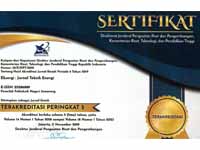Evaluation of the Efficiency and Stability of High-Frequency Inverters Under Varying Load Profiles in Photovoltaic Systems
DOI:
https://doi.org/10.32497/eksergi.v21i03.7111Keywords:
High Frequency Inverter, Resistive Load, Inductive Load, Solar Power Plant, EfficiencyAbstract
This research undertakes an operational performance analysis of a high-frequency inverter (HFI) within a Solar Power Plant (SPP) system configuration. The investigation prioritizes assessing the effects of pure resistive and mixed resistive-inductive load profiles on its efficiency stability. Experimental findings definitively demonstrate that the HFI inherently maintains superior efficiency stability when operating under purely resistive loads. Conversely, the introduction of varying inductive loads tends to compromise this efficiency stability, inducing significant fluctuations. These results yield crucial recommendations, establishing that HFIs are optimally suited for systems with predominantly resistive loads, thereby contributing to the overall system power efficiency enhancement
References
[1] ESDM, “72F25-Web-Publish-Statistik-2022,” Statistik Ketenagalistrikan Pln, vol. 36, pp. 1–114, 2022.
[2] H. B. Nurjaman and T. Purnama, “Pembangkit Listrik Tenaga Surya (PLTS) Sebagai Solusi Energi Terbarukan Rumah Tangga,” Jurnal Edukasi Elektro, vol. 6, no. 2, pp. 136–142, 2022, doi: 10.21831/jee.v6i2.51617.
[3] D. Hendrawati, B. W. Dionova, Sahid, J. Mukhlis, and A. Khoryanton, “Design of Wind Turbines Power Coefficient on Wind Farm Based Centralized Control,” in Proceedings - 2021 International Seminar on Intelligent Technology and Its Application: Intelligent Systems for the New Normal Era, ISITIA 2021, 2021, pp. 315–318. doi: 10.1109/ISITIA52817.2021.9502251.
[4] A. SARI and R. DOĞAN, “Techno-Economic analysis of A Stand-Alone hybrid renewable energy system (Solar/Fuel Cell/Battery) and grid extension for two residential Districts,” Ain Shams Engineering Journal, vol. 15, no. September, 2024, doi: 10.1016/j.asej.2024.103062.
[5] S. Al-Ali, A. G. Olabi, and M. Mahmoud, “A review of solar photovoltaic technologies: developments, challenges, and future perspectives,” Energy Conversion and Management: X, vol. 27, no. April, p. 101057, 2025, doi: 10.1016/j.ecmx.2025.101057.
[6] W. Li, Y. Gu, H. Luo, W. Cui, X. He, and C. Xia, “Topology review and derivation methodology of single-phase transformerless photovoltaic inverters for leakage current suppression,” IEEE Transactions on Industrial Electronics, vol. 62, no. 7, pp. 4537–4551, 2015, doi: 10.1109/TIE.2015.2399278.
[7] K. Janardhan, A. Mittal, and A. Ojha, “Performance investigation of stand-alone solar photovoltaic system with single phase micro multilevel inverter,” Energy Reports, vol. 6, pp. 2044–2055, 2020, doi: 10.1016/j.egyr.2020.07.006.
[8] P. P. Brancaleoni, G. Silvagni, V. Ravaglioli, E. Corti, and D. Moro, “Hybrid solar and hydrogen energy system 0-D model for off-grid sustainable power system: A case in Italy,” International Journal of Hydrogen Energy, vol. 92, no. October, pp. 1108–1120, 2024, doi: 10.1016/j.ijhydene.2024.10.284.
[9] Y Liu, X Wu, J Gao, Y Li, and Z Wang, “Impact of Frequency Control Strategies on Power System Stability and Reliability,” Energies, vol. 13, no. 6, 2020.
[10] D. Darmawardana, S. Perera, J. Meyer, D. Robinson, U. Jayatunga, and S. Elphick, “Development of high frequency (Supraharmonic) models of small-scale (<5 kW), single-phase, grid-tied PV inverters based on laboratory experiments,” Electric Power Systems Research, vol. 177, no. June, 2019, doi: 10.1016/j.epsr.2019.105990.
[11] D. Hendrawati, B. Widi Dionova, A. Surya Wardhana, T. Prasetyo, and M. N. Mohammed, “DESIGN AND PERFORMANCE EVALUATION OF ANALYTIC-TUNING PID ON BOOST CONVERTER FOR 200 WP PHOTOVOLTAIC,” 2023.
[12] D. Mathew and R. C. Naidu, “A review on single-phase boost inverter technology for low power grid integrated solar PV applications,” Ain Shams Engineering Journal, vol. 15, no. 2, 2024, doi: 10.1016/j.asej.2023.102365.
[13] C. Photong, “A current source inverter with series AC capacitors for transformerless grid-tied photovoltaic applications,” no. February, pp. 1–280, 2013.
[14] M. A. G. de Brito, E. H. B. Dourado, L. P. Sampaio, S. A. O. da Silva, and R. C. Garcia, “Sliding Mode Control for Single-Phase Grid-Connected Voltage Source Inverter with L and LCL Filters,” Eng, vol. 4, no. 1, pp. 301–316, 2023, doi: 10.3390/eng4010018.
[15] Y. M. Safarudin, D. Mariani, D. Hendrawati, S. Suwarti, M. Ali, and H. Nurrohmah, “Perancangan Perangkat Keras MPPT Metode Perturb and Observation,” Jurnal Sustainable: Jurnal Hasil Penelitian dan Industri Terapan, vol. 7, no. 2, pp. 46–52, 2018, doi: 10.31629/sustainable.v7i2.437.
[16] X. Wang, P. Adelmann, and T. Reindl, “Use of LiFePO4 batteries in stand-alone solar system,” Energy Procedia, vol. 25, pp. 135–140, 2012, doi: 10.1016/j.egypro.2012.07.018.
Downloads
Published
Issue
Section
License
Copyright (c) 2025 Nabila Aida Az Zahro, Langga Samaratungga, Dwiana Hendrawati, Aggie Brenda Ferandez, Erwan Tri Efendi

This work is licensed under a Creative Commons Attribution 4.0 International License.
Authors who publish with this journal agree to the following terms:Authors retain copyright and grant the journal right of first publication with the work simultaneously licensed under a Creative Commons Attribution License that allows others to share the work with an acknowledgement of the work's authorship and initial publication in this journal.
Authors are able to enter into separate, additional contractual arrangements for the non-exclusive distribution of the journal's published version of the work (e.g., post it to an institutional repository or publish it in a book), with an acknowledgement of its initial publication in this journal.
Authors are permitted and encouraged to post their work online (e.g., in institutional repositories or on their website) prior to and during the submission process, as it can lead to productive exchanges, as well as earlier and greater citation of published work (See The Effect of Open Access).






